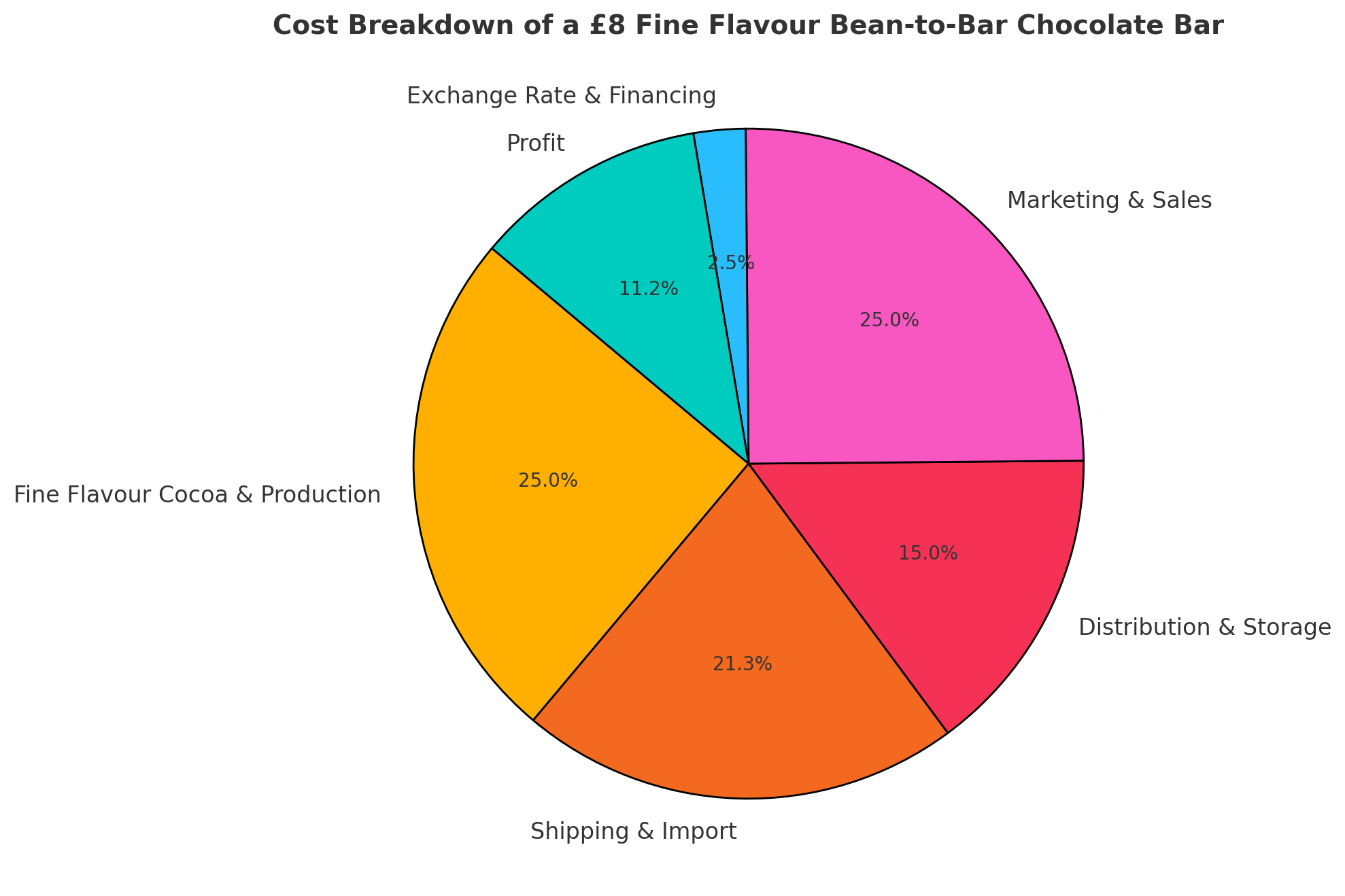 Reflections from Chocoa 2025, Amsterdam
Reflections from Chocoa 2025, Amsterdam
This past week at @Chocoa in Amsterdam, I had the pleasure of meeting many friends—producers of some of the world’s finest fine flavour cocoa. One recurring topic of conversation was the pricing disparity between what cocoa farmers receive at origin and the retail price of chocolate in Europe. It’s easy to look at an £8 bar on the shelf and wonder— why isn’t more of this going to the farmer?
The reality is, craft bean-to-bar chocolate—especially using fine flavour cocoa—involves a complex and costly supply chain.
To provide full transparency, here’s a breakdown of the actual costs involved in producing, shipping, and selling a 50g bar made with fine flavour cocoa from Togo to the UK.
1. Cost Breakdown Estimates (Per Bar)
(With help from some of my Neil & Jonathan friends)
A) Cost of Fine Flavour Cocoa & Production (C)
Includes:
Farm Gate Cocoa Price (fine flavour cocoa commands a premium over commodity-grade)
Post-Harvest Processing: Proper fermentation & drying enhance flavour, increasing costs
Additional ingredients (high-quality sugar, milk powder, inclusions where applicable)
Labour & energy costs (small-batch, low-yield production)
Packaging (high-quality, tested to prevent damage in transit)
Packaging Consideration:
Fine chocolate makers cannot afford packaging failures. Marou’s SOT packaging resulted in over 1,000 bars needing remoulding—a costly mistake. At this level of production, every broken bar costs £3-4 to replace.
Estimated Cost: £2.00 per bar (Premium packaging included to prevent breakage.)
B) International Shipping & Import Duties (S)
Includes:
Customs clearance & trucking to port/airport (critical for FOB pricing)
Temperature-controlled shipping (essential for fine flavour chocolate; bloom can destroy quality)
Freight cost per bar (bulk shipment via sea vs. air freight)
Customs duties & VAT (UK import duty on chocolate 8-10%)
Import clearance fees
Shipping Consideration:
By air freight: UPS has historically charged $6/kg (excluding duty), but prices fluctuate.
By sea freight: A reefer container is non-negotiable to maintain quality.
Estimated Cost: £1.70 per bar (Reflecting air vs. sea freight realities.)
C) Distribution & Storage (D)
Includes:
Warehousing in the UK (cold storage if required for fine flavour chocolate)
UK logistics (transport from port to distributor/retailer)
Last-mile delivery (direct-to-consumer or retail stockists)
Storage Consideration:
For fine flavour chocolate, temperature & humidity control is essential. A makeshift warehouse isn’t an option.
Estimated Cost: £1.20 per bar (Ensuring a professional logistics hub is used.)
D) Marketing & Sales (M)
Includes:
Branding & design (vital for premium positioning in fine flavour markets)
Photography & content creation (essential for storytelling & consumer education)
Retailer margins (typically 30-50% on premium craft chocolate)
Distributor margin (usually 15-18% for specialty brands)
POS materials (unlike established brands, new makers must invest in these from scratch)
Online store costs (website, ads, transaction fees, direct-to-consumer logistics)
Estimated Cost: £2.00 per bar
E) Exchange Rate & Financing Costs (F)
Includes:
USD-based expenses (cocoa, shipping, equipment purchases)
Currency fluctuations (especially relevant for fine flavour markets dependent on dollar-based trade)
Financing costs (if capital is borrowed for production/shipping)
Estimated Buffer: £0.20 per bar (Accounting for currency risks & potential financing costs.)
F) Desired Profit (P)
Includes:
Ensuring reinvestment & sustainable growth
Maintaining a viable margin for fine flavour chocolate makers
Targeted Profit: £1.60 per bar
2. Full Cost Calculation
Cost Component Estimated Cost Per Bar (£)
Fine Flavour Cocoa & Production (C) £2.00
Shipping & Import (S) £1.70
Distribution & Storage (D) £1.20
Marketing & Sales (M) £2.00
Exchange Rate & Financing (F) £0.20
Total Cost £7.10
Retail Price £8.00
Profit per Bar £0.90
3. Key Considerations for Fine Flavour Chocolate Makers
Fine flavour cocoa commands a premium at farm gate level, but post-harvest handling costs more
High-quality packaging is essential to avoid waste (£3-4 per damaged bar replacement cost)
Customs clearance & trucking to port/airport must be included in FOB pricing
Temperature-controlled shipping is non-negotiable—bloom ruins fine flavour chocolate
Distributing via a professional logistics hub (not a basic warehouse) ensures product integrity
Exchange rate fluctuations impact pricing, especially for small-batch fine chocolate brands
Retailer & distributor margins must be factored in (30-50% for retail, 15-18% for distributors)
Final Thought: A Sustainable Price for Fine Flavour Chocolate?
To ensure long-term sustainability, the retail price of fine flavour chocolate should move closer to £8.50-£9.00 to absorb:
Currency fluctuations
Air freight costs (if needed for freshness)
Premium packaging & quality control
This refined cost model highlights
why fine flavour cocoa must be priced fairly and why farmers should not compare commodity cocoa pricing to craft chocolate retail prices. The value in fine flavour chocolate is in its quality, craftsmanship, and storytelling—something that must be reflected in the price.
For craft chocolate makers sourcing fine flavour cocoa, pricing transparency is critical to fostering sustainable and equitable trade relationships.
Why This Matters to Fine Flavour Cocoa Producers
This breakdown can help fine cocoa farmers understand where the value is added in the supply chain and why craft chocolate makers cannot compete with industrial brands on price—but also why they shouldn't try.
Would love to hear more thoughts from producers, chocolate makers, and those working in fine flavour cocoa—how do you see these pricing challenges? Let’s continue the conversation.
